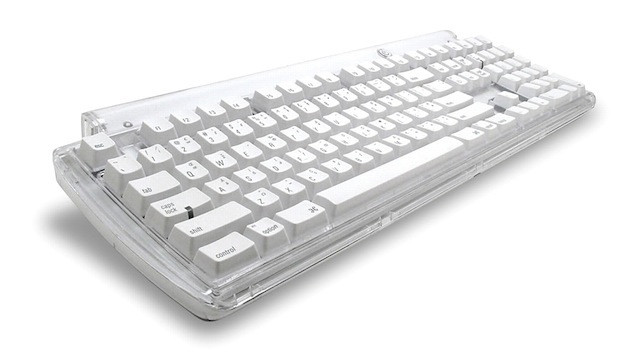Most computer users tend toward what’s already there. Windows, Internet Explorer and Google Search are prime examples of this tendency. It’s a sad truth that most people don’t realize they have a choice, and even if they do, they don’t have the time or energy to research and evaluate their options.
Keyboards are no exception. The majority of desktop computers today are sold with rubber dome or scissor switch keyboards. They’re cheap and most consumers don’t know what they’re missing. Even when you order a computer online and have optional keyboard upgrades, the options are limited to low profile or more expensive rubber domes. A little history would help to explain this.
In the early days of personal computers, keyboards were large, expensive devices. They consisted of a sturdy printed circuit board with mechanical switches and a sturdy case. Each switch had it’s own diode, which meant that each key press could be detected on its own. This quality came at a price and these keyboards cost well over $100. When the price of the average personal computer generally ranged between $2,000 – $5,000, this additional price was negligible.
However, as computers dropped in price, consumers were less willing to shell out $100 – $200 on a keyboard. And manufacturers were under pressure to produce complete systems for under $1,000, which didn’t leave room for an expensive keyboard.
Enter the rubber dome membrane keyboard. The circuit was printed on a series of flexible membranes and the keys were supported by rubber domes instead of springs. All of these components are very inexpensive, resulting in a great deal of keyboards available for under $20.
Today, we’ve become accustomed to the idea that most keyboards on the market are of either the rubber dome or scissor switch variety. Rubber domes are most common in desktop keyboards, while scissor switches are the dominant switch in laptops and low profile keyboards.
They may be cheap, but there are several shortcomings in these keyboards.
- Build quality – Rubber dome keyboards are made of cheaper components than most mechanical keyboards. The rubber domes are cheaper than springs and switches. The circuits are printed on thin plastic sheets instead of circuit boards. There is not a diode for each key. The key caps are typically made of cheaper plastic. As a result, cheaper rubber dome and scissor switch keyboards are cheaper and don’t last as long.
- Actuation – Rubber dome keyboards give no indication of when they have produced an actual keystroke. This results in the need to bottom out the key to be sure you’ve typed what you think you typed. This causes unnecessary jolting to your hands. Although scissor switches give some tactile response, they only have two positions: up or down. This also results in bottoming out on each keystroke.
- Accidental clicking – Rubber domes are not as firm as springs. On many rubber dome keyboards, you can accidentally click keys simply by resting your fingers on the home row. The same problem exists with most scissor switches. (If you don’t know what the home row is, you should learn how to type.)
- Ghosting – Without a diode per key, rubber dome keyboards (and most scissor switches) have trouble with certain key combinations, resulting in missing characters or unexpected characters being typed.
Mechanical keyboards address the shortcomings of the common mass market keyboard in the following ways:
- Build quality – Most mechanical keyboards use better quality plastic and laser etch the letters on the key caps. Each key switch is mounted to a solid circuit board, each with its own diode. The case is made of high quality plastic or metal. Typical mechanical key switches have a lifespan of 50 million clicks.
- Actuation – Mechanical keyboards have a consistent actuation point about halfway through a key press. You are not required to bottom out the key in order to type a character. Once you learn to take advantage of this, you can reduce the stress on your fingers when typing.
- Accidental clicking – The switches on most mechanical keyboards are firmer than rubber domes or scissor switches. You won’t accidentally type characters simply by resting your fingers on the home row.
- Ghosting – Each key has a diode of its own. This means that there are no key combinations that won’t work. There is no speed at which you can type that the keyboard can’t register all the keystrokes. If you’re a gamer, this means that you can do multiple things at once without worrying that some of them won’t happen.
As consumers, we are accustomed to hype and higher prices for products that don’t deserve them. You don’t always get what you pay for. But when it comes to keyboards, a mechanical option is clearly a better product for the price and will last quite a bit longer. The only thing remaining is to choose one, which I’ll address in another article.

